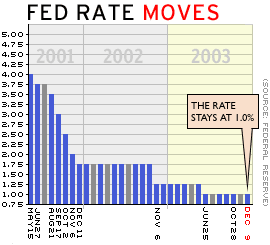NEW YORK (CNN/Money) -
With the economy sprinting but generating little inflationary heat, the Fed is likely to keep the accelerator on the floor and hold a key interest rate at the lowest level in more than 40 years when policy-makers meet this week.
Federal Reserve policy-makers begin a two-day meeting Tuesday, and economists believe they will keep the federal funds rate, an overnight bank lending rate that is the basis for many banks' prime rates, at 1 percent, a level not seen consistently since 1961.

What's more, given December's exceptionally weak jobs report, policy-makers at the nation's central bank are likely to reiterate that they're probably going to keep rates low for some time to come.
"They will convey more or less the same message -- that the economy is looking better, but nothing that would convey the notion that they're going to be moving rates any time soon," said Joshua Feinman, chief economist with Deutsche Bank Asset Management.
After its last meeting in December, the Fed said that, despite "briskly expanding" output and a "modestly improving" labor market, inflation was "quite low," meaning it could afford to keep interest rates low for a "considerable period."
Since that meeting, the government has reported that gross domestic product (GDP), the broadest measure of the economy, grew at an 8.2 percent rate in the third quarter, the fastest pace in 20 years.
What's more, many economists expect strong GDP growth in the fourth quarter, owing to strong corporate profits, a brisk recovery in manufacturing, resilient strength in the housing market, a drop in the trade deficit and a build-up of business inventories.
| Related stories
|

|
|
|
|
Some analysts, in fact, worry that by waiting too long to raise interest rates, and leaving the economy running at top speed, the Fed may be helping to create runaway inflation -- either in consumer prices or by inflating a dangerous bubble in stocks or home prices -- that could come back to cripple the economy.
They've got some evidence backing them up, too: gold and raw material prices have surged, the dollar has weakened, and the gap in the yields of inflation-protected Treasury bonds and normal Treasurys is widening – all leading indicators of inflation.
But that inflation hasn't shown up in broader measures yet. The Fed's favorite gauge, a Commerce Department reading on consumer price inflation, grew at its slowest pace in history in the 12 months ended in November.
Labor-market weakness is the prime culprit, according to Fed Governor Ben Bernanke and some other economists. Technology-driven productivity gains have allowed companies to squeeze more work out of fewer workers, and many firms are sending work overseas, where labor costs are much cheaper.
As a result, the economy has been able to grow like gangbusters without adding many jobs -- last month the U.S. generated just 1,000 new jobs, versus forecasts for a gain of about 150,000. And despite the pickup in economic growth, wage and salary growth -- by far the biggest component of consumer price inflation -- have been held in check.
And it could slow down even more, according to a note Friday by Citigroup's chief U.S. economist, Robert DiClemente.
DiClemente said the amazing gap between robust economic growth and inflation could mean productivity -- worker output per hour -- will continue to be stronger than most analysts expect.
Fueled by technological innovation, productivity grew at a 5.4 percent pace in 2003, the fastest in 53 years. Most economists believe it will -- in fact, must -- slow down in 2004, and that businesses will be forced to start hiring in bigger numbers to keep up with demand.
But DiClemente said sluggish growth in new jobs and average worker earnings, among other things, are starting to raise questions about just how much slack the economy will take up, even if it grows at a strong pace throughout 2004.
"Under these conditions, policy-makers will want to maintain a continued period of very low interest rates and highly accommodative financial conditions to propel aggregate demand well above the upper end of reasonable estimates of potential growth," DiClemente wrote.
 |
YOUR E-MAIL ALERTS
|
Follow the news that matters to you. Create your own alert to be notified on topics you're interested in.
Or, visit Popular Alerts for suggestions.
|
|
|
In other words, the Fed's pedal may stay pressed to the metal for quite some time -- until 2005, according to some economists.
Still, some in the financial markets disagree. In the fed funds futures market, where traders bet on Fed policy moves, the numbers show these traders believe there's a decent chance the Fed will start raising rates by the late summer or early fall.
And most economists agree. A recent Bloomberg poll found that 13 out of 23 economists expected a rate hike in 2004, and the Economic Advisory Committee of the American Bankers Association said Friday they expected a hike as early as June.
Some of these analysts say the Fed won't wait for higher inflation to start raising rates, but just for signs that the labor market has truly healed, something that could come later this year, according to some forecasters.

|